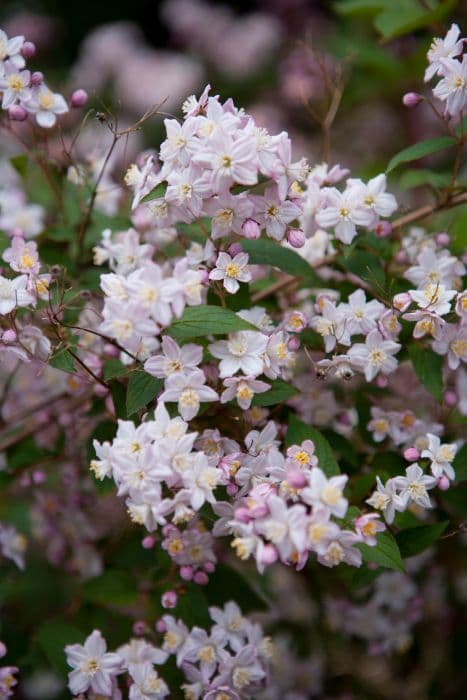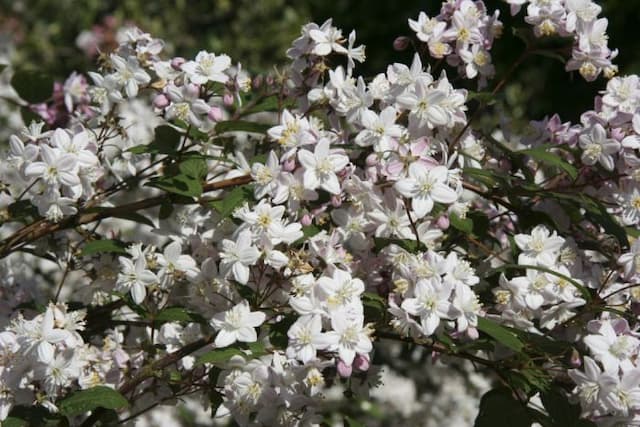Peegee Hydrangea Hydrangea paniculata 'Praecox'

ABOUT
The Hydrangea paniculata 'Praecox', commonly known as the early panicled hydrangea, is a deciduous shrub with an appealing aesthetic. This plant is known for its beautiful flowers which start out a soft green color and then develop into a mix of white and pink as they mature. The flowers are quite large and cone-shaped, arranged in panicles that make for a stunning display during its blooming season. As the flowers age, they may acquire a pinkish hue, adding further interest to the plant's appearance. The leaves of the early panicled hydrangea are oval-shaped with pointed tips and have a deep green color that serves as a perfect backdrop for the eye-catching blooms. These leaves can turn to lovely shades of yellow or bronze in the autumn before they fall, making the plant attractive across different seasons. Moreover, the shrub has a rounded habit with sturdy stems that support the weight of the blooms well. The bark and stems may not be as showy as the flowers or foliage, but they have a solid presence that provides structure to the plant even in the winter months after the leaves have dropped. Overall, the early panicled hydrangea is a visually pleasing plant that can add color and form to gardens and landscapes.
About this plant
 Names
NamesFamily
Hydrangeaceae
Synonyms
Early Panicle Hydrangea, Precocious Hydrangea
Common names
Hydrangea paniculata 'Praecox'.
 Toxicity
ToxicityTo humans
The plant commonly known as the panicle hydrangea is not considered highly toxic to humans. However, it contains compounds called cyanogenic glycosides, which can release cyanide if ingested in large quantities. Consumption of parts of the plant, especially the leaves and buds, may lead to mild symptoms such as nausea, vomiting, and diarrhea. It is generally advised to avoid ingesting parts of the panicle hydrangea to prevent the potential for poisoning and its adverse effects.
To pets
The panicle hydrangea is considered mildly to moderately toxic to pets if ingested due to the cyanogenic glycosides it contains. If a pet, such as a dog or cat, ingests parts of the plant, it may experience symptoms of poisoning, which can include vomiting, diarrhea, lethargy, abdominal pain, and in rare cases, more severe symptoms like difficulty breathing or increased heart rate could occur. It's important to keep pets away from this plant to prevent any risk of poisoning.
 Characteristics
CharacteristicsLife cycle
Perennials
Foliage type
Deciduous
Color of leaves
Green
Flower color
White
Height
6-10 feet (1.8-3 meters)
Spread
6-10 feet (1.8-3 meters)
Plant type
Shrub
Hardiness zones
3-8
Native area
China, Japan, Korea
Benefits
 General Benefits
General Benefits- Ornamental Appeal: Hydrangea paniculata 'Praecox', commonly known as Panicled Hydrangea, adds aesthetic value to gardens with its large, showy flower heads that can vary in color from white to pink.
- Extended Blooming Season: This cultivar blooms earlier than other hydrangeas, providing visual interest in gardens from late spring to autumn.
- Low Maintenance: Panicled Hydrangea requires minimal care once established, making it suitable for gardeners of all skill levels.
- Drought Tolerance: Once established, it exhibits some drought tolerance, which is beneficial in areas with water restrictions or less frequent rainfall.
- Wildlife Attraction: The flowers attract pollinators such as bees and butterflies, supporting local ecosystems and biodiversity.
- Hardiness: This plant is hardy in a wide range of climates, which makes it a robust addition to many gardens across different USDA zones.
- Versatility: It can be planted in garden beds, borders, or as a stand-alone specimen, and can also be used in cut-flower arrangements.
- Seasonal Interest: In the fall, the leaves may turn a vibrant array of colors, adding further interest to the garden.
 Medical Properties
Medical PropertiesThis plant is not used for medical purposes.
 Air-purifying Qualities
Air-purifying QualitiesThis plant is not specifically known for air purifying qualities.
 Other Uses
Other Uses- Hydrangea paniculata 'Praecox', commonly known as panicle hydrangea, can be used in dried floral arrangements. Its sturdy stems support the large blooms well, even when dried.
- The wood of the panicle hydrangea is dense and can be carved into small objects or used for intricate woodworking projects once properly dried and treated.
- Panicle hydrangea flowers can be pressed and used in craft projects such as making bookmarks, cards, or framed botanical art.
- The large blooms can be used as natural dye sources; the colors can vary depending on the pH level of the soil in which the plant was grown.
- When planted in groups, panicle hydrangeas can act as a natural privacy screen during the summer months when they are in full bloom.
- The leaves of the panicle hydrangea can be used as a natural mulch, providing soil enrichment and weed control when decomposed.
- During the winter, the bare stems of panicle hydrangeas can provide interesting visual structure and texture to a garden landscape.
- The faded flower heads of panicle hydrangeas can be used in winter gardens to offer food and shelter for birds.
- Large panicle hydrangea plants can be used in theater productions or event decorations to create a naturalistic backdrop or setting.
- In photography, the varied hues of panicle hydrangeas can be used as a vivid background to enhance portrait and macro photography.
Interesting Facts
 Feng Shui
Feng ShuiThe Panicled Hydrangea is not used in Feng Shui practice.
 Zodiac Sign Compitability
Zodiac Sign CompitabilityThe Panicled Hydrangea is not used in astrology practice.
 Plant Symbolism
Plant Symbolism- Heartfelt Emotions: Hydrangeas are often associated with deep, heartfelt emotions due to their lush and full blooms.
- Gratitude: In some cultures, giving hydrangeas is a way to express gratitude for the recipient's understanding and patience.
- Abundance: The large, abundant flowers can symbolize prosperity and abundance.
- Vanity or Frivolity: In certain contexts, the hydrangea may denote vanity or boastfulness due to its showy appearance.
- Apology or Remorse: Some people give hydrangeas when they wish to seek forgiveness or express regret over a past action.
 Water
WaterThe PeeGee Hydrangea should be watered deeply, ensuring that the soil is thoroughly moistened. During the first growing season, it is crucial to establish a strong root system by watering regularly, about 2-3 times per week. Once established, reduce watering to once a week, providing about 1 gallon of water per session for each plant, though this may need to be adjusted during periods of extreme heat or drought. Overhead watering can lead to leaf spot diseases, so it's best to apply water directly to the base of the plant. During winter, reduce watering since the plant requires less moisture when dormant.
 Light
LightThe PeeGee Hydrangea thrives in full sun to partial shade. Ideally, it should receive at least 4-6 hours of sunlight a day, but it also benefits from some afternoon shade in hotter climates. The best spot would be one where it receives morning sunlight and some protection from the intense afternoon sun, which can be harsh, especially in southern climates.
 Temperature
TemperaturePeeGee Hydrangeas prefer temperate climates and perform best when daytime temperatures are between 65°F and 75°F. However, they can survive in temperatures as low as 0°F in winter and can tolerate heat up to 90°F in summer, although prolonged heat can stress the plant. Providing adequate mulch can help insulate the roots and maintain consistent soil temperatures.
 Pruning
PruningPrune the PeeGee Hydrangea in late winter or early spring before new growth starts, as it blooms on new wood. Pruning is done to encourage healthy growth, remove dead or weakened stems, and maintain a desired shape or size. Cut back about one-third of the older stems each year, which stimulates the production of new, more vigorous growth. Pruning just after bloom is not recommended as it may cut into next year's flower buds.
 Cleaning
CleaningAs needed
 Soil
SoilPanicled hydrangea ('Praecox') thrives in a soil mix that is well-draining and rich in organic matter. The ideal soil pH for this plant is slightly acidic to neutral, ranging from 5.5 to 7. A mixture of garden soil, compost, and peat moss can create an optimal environment for growth.
 Repotting
RepottingPanicled hydrangea ('Praecox') generally does not require frequent repotting and can be done every 3 to 5 years. It's best to repot in spring before the growing season begins, choosing a container only slightly larger than the previous one to avoid overwatering issues.
 Humidity & Misting
Humidity & MistingPanicled hydrangea ('Praecox') tolerates a wide range of humidity levels but prefers moderate humidity. It does well in outdoor conditions where humidity mirrors the local environment, avoiding extremely dry or overly humid conditions.
 Suitable locations
Suitable locationsIndoor
Place panicled hydrangea in bright, indirect light and monitor moisture.
Outdoor
Plant in partial shade, ensure well-draining soil, and mulch-root zone.
Hardiness zone
3-8 USDA
 Life cycle
Life cycleThe life of Hydrangea paniculata 'Praecox', commonly known as the early panicled hydrangea, begins with seed germination in suitable conditions of moisture and temperature. The seedling emerges and develops into a juvenile plant, focusing on root and foliage growth. As the plant matures, it enters the vegetative stage, during which it grows larger and stronger, preparing for flowering. During the reproductive stage, typically in early summer, it produces conical clusters of white flowers that may age to a pinkish hue. After pollination, if it occurs, the flowers give way to seed pods that, when mature, release seeds to complete the life cycle. In autumn, the plant enters dormancy, with leaves turning yellow and dropping off, conserving energy for the next growing season.
 Propogation
PropogationPropogation time
Summer
The Hydrangea paniculata 'Praecox', commonly known as the early-panicle hydrangea, is typically propagated during the dormant season in late winter to early spring. The most popular method of propagation for this plant is through softwood cuttings. You would take a cutting from a healthy branch that's about 4 to 6 inches long, making sure there are at least two sets of leaves. Remove the lower set of leaves and dip the cut end in rooting hormone to encourage root development. Then plant the cutting in a well-draining soil mix, ensuring that the node where the leaves were removed is buried, as this is where the roots will develop. The cutting should be kept in a warm, humid environment with indirect light until it is well-rooted, which typically takes several weeks. Regular misting may be necessary to maintain humidity.








![Hydrangea [Early Sensation]](/_next/image?url=https%3A%2F%2Fplants-admin.emdemapps.com%2Fimages%2Fplants%2F%2Fimages%2F604b6150338db.png&w=640&q=75)
